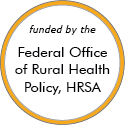Rural Project Examples: Service delivery models
Promising Examples
Cross-Walk: Integrating Behavioral Health and Primary Care

Updated/reviewed May 2024
- Need: To address and treat substance use disorder (SUD) and depression in the Upper Great Lakes region.
- Intervention: Cross-Walk, a program that integrates behavioral healthcare into primary care services, was developed in Michigan's Marquette County.
- Results: The collaborative efforts strengthened care management services in local healthcare facilities as primary care patients were referred to a behavioral health specialist.
Maryland Faith Health Network
Updated/reviewed December 2022
- Need: To coordinate formal and informal community-based caregivers for optimal patient experience.
- Intervention: The Maryland Faith Health Network unites places of worship and healthcare systems in Maryland. This program aims to decrease the amount of potentially avoidable hospitalizations, improve a patient's overall wellness, and cut down on the cost of medical services.
- Results: This model is currently running in 3 hospitals that serve both rural and urban residents in central Maryland. So far, 1,300 congregants from 70 congregations representing Christian, Jewish, and Muslim faiths have enrolled in the Network.
Atlantic General Hospital Patient Centered Medical Home
Updated/reviewed August 2022
- Need: Ways to reduce hospital admission rates, emergency department visits, and total cost of care while better accommodating patients of the Atlantic General Hospital Corporation.
- Intervention: The hospital system applied a patient centered medical home care model to their 7 rural outpatient clinics located throughout the Eastern Shore of Maryland and southern Delaware.
- Results: From the program's care coordination, care transitions, and intervention efforts, AGH saw improvements in quality-of-care processes, service use, and spending.
Other Project Examples
Mobile Integrated Healthcare Network (MIHN)

Updated/reviewed November 2025
- Need: To bring preventive care and other services to rural Missouri patients with chronic illnesses and difficulties accessing primary care.
- Intervention: Community paramedics make home visits and provide basic care, home assessments, and medication reconciliation and facilitate telehealth visits.
- Results: Patients experienced improved access to care, health status, and compliance with medication regimens along with increased patient engagement, satisfaction, and access to community resources.
ADPH Telehealth Program
Updated/reviewed October 2025
- Need: To increase access to healthcare throughout Alabama.
- Intervention: The Alabama Department of Public Health (ADPH) has created telehealth communications at county health departments.
- Results: ADPH telehealth services are currently available in 65 of 67 county health departments.
Clinic for Special Children
Updated/reviewed August 2025
- Need: To provide healthcare for children and adults at-risk for genetic conditions from the rural, uninsured Amish and Mennonite communities in southern Pennsylvania.
- Intervention: A clinic that serves as a comprehensive medical practice for children and adults (primarily from the Amish and Mennonite communities) with rare, inherited, or complex disorders.
- Results: In 2024, about 1,700 active patients with more than 480 unique genetic mutations were treated at the Clinic for Special Children.
COPD Readmission Prevention Program
Updated/reviewed August 2025
- Need: Organized focus on COPD patients' medical needs to decrease hospital readmissions in a rural Ohio healthcare system.
- Intervention: Creation of an integrated system model with nurse navigators central to evidence-based chronic disease care management approaches to COPD care.
- Results: Since its creation in 2014, the model continues to mature its comprehensive approach to provide optimized acute and chronic care for the area's COPD patients.
The Massachusetts Department of Public Health TeleSANE Center
Updated/reviewed July 2025
- Need: Clinicians in rural and underserved areas are often unprepared to provide comprehensive medical-forensic examinations for patients who present for care following a sexual assault.
- Intervention: The MDPH TeleSANE Center uses secure telehealth software to connect sexual assault nurse examiners to clinicians and patients in hospitals across Massachusetts — including five in rural counties — offering expert clinical guidance and support before, during, and after examinations.
- Results: Clinicians report that the service gives them increased confidence throughout the examination process. To date, the MDPH TeleSANE Center has assisted in the care of over 1,234 patients.
Auburn University Rural Health Initiative
Updated/reviewed May 2025
- Need: To expand healthcare access in rural Alabama communities.
- Intervention: The Auburn University Rural Health Initiative is working with communities across Alabama to develop a healthcare model that includes primary care, substance use disorder treatment and mental health treatment via state-of-the-art telehealth technologies, coupled with health and wellness programs and services provided by faculty and students.
- Results: As of 2025, there are five telehealth care stations open located in LaFayette, Boligee, Akron, Catherine, and Gainesville, Alabama. These stations have impacted over 3,400 individuals, with 187 community events, 1207 patient consultations, and 43 new health ambassadors.
Queen Anne's County Mobile Integrated Community Health (MICH) Program
Updated/reviewed May 2025
- Need: To connect patients to resources in order to reduce use of emergency services, emergency department visits, and hospital readmissions.
- Intervention: Patients receive support (by in-person visit, phone call, or telehealth visit) from a paramedic, community health nurse, peer recovery specialist, and pharmacist.
- Results: Between July 2016 and March 2024, the program made 1,098 patient contacts and continued to see a reduction in emergency department and inpatient visits and costs.
For examples from other sources, see:
